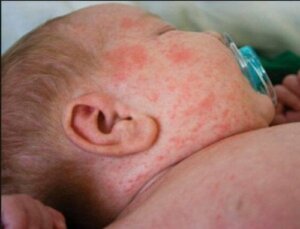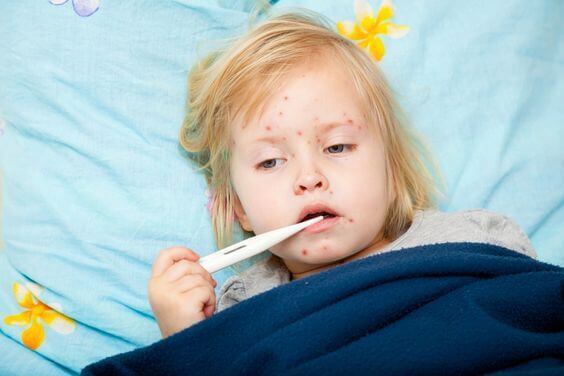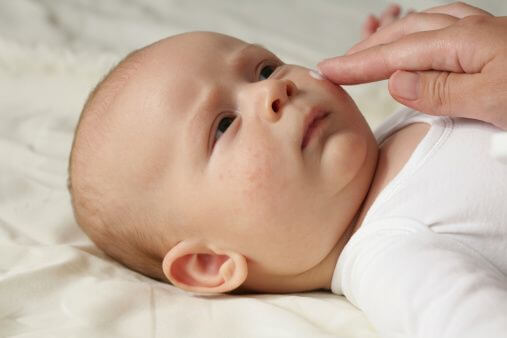What Are Those Little Red Spots on My Baby's Skin?

Sometimes babies tend to suffer from the same problems. For example, little red spots on the skin are common in many cases. However, the cause is not always the same or entirely clear.
Usually, this type of skin condition is caused by the typical chickenpox, but it can be caused by other things as well. Some children may develop diseases that aren’t common in this population, so it can be difficult to identify them.
Exanthema or red spots

Rashes that appear in the form of red spots are called exanthema by doctors. They vary in size and shape, are usually itchy, and appear on different areas of the body. They can spread completely over the skin or appear in specific places.
The main childhood diseases that cause these rashes are chickenpox, measles, and rubella. However, nowadays, these conditions are almost non-existent due to vaccinations. Therefore, many mothers can be caught off guard, unable to determine what is wrong with their baby.
On the other hand, experts point out that 70% of the time, these types of spots appear due to viral diseases. In this sense, they end up disappearing by themselves without worsening. Nevertheless, it’s always advisable to take them to the pediatrician, especially when there are other symptoms at the same time.
Main causes of red spots on the skin
To prevent the diseases that cause these rashes from affecting our babies, it’s very important to keep their vaccinations up to date. However, as we’ve said, these spots can be caused by conditions that aren’t common in children.

Likewise, it’s important to know which are the diseases that cause these red spots on the skin. Among others, we have the following:
Varicella (Chickenpox)
This usually affects children between two and ten years of age. It’s one of the most common diseases in children. It can also appear in infants and adults, but less frequently. It’s caused by a virus that’s highly contagious.
This virus remains in the body for a long time, so it’s capable of reappearing. Symptoms include fever, joint pain, headaches, and red spots on the skin.
Atopic dermatitis
It’s among the most common skin conditions in infants and young children. Its most noticeable symptom is the appearance of a rash that causes itching, dryness, and flaking. In some cases, small outbreaks cause crusting and irritation over large areas of skin.
Rubella
This is also a disease caused by a virus. It’s typical in children, among whom it can spread rapidly. In addition to the little red spots on the skin, other symptoms such as cough, fever, and swollen glands may occur.
Scarlet fever
Unlike other similar diseases, scarlet fever is caused by streptococci, bacteria that affect children. It’s relatively contagious, mainly transmitted by sneezing and saliva droplets. Symptoms associated with this disease are red spots on the skin, fever, sore throat, nausea, and skin rash.
Impetigo
This infection caused by bacteria is characterized by the appearance of rashes that usually end in blisters. It’s spread by contact with the affected person’s skin. The main areas affected are the face, neck, diaper area, and hands.
Measles
Like other similar diseases, measles has been almost eradicated by vaccination. For this reason, cases are less frequent. It’s a highly contagious viral disease, but once overcome, it never recurs.
It can be recognized by the appearance of a rash on the skin that occurs after the disease is advanced. The initial symptoms are similar to those of a cold and last for about three days.
Sometimes babies tend to suffer from the same problems. For example, little red spots on the skin are common in many cases. However, the cause is not always the same or entirely clear.
Usually, this type of skin condition is caused by the typical chickenpox, but it can be caused by other things as well. Some children may develop diseases that aren’t common in this population, so it can be difficult to identify them.
Exanthema or red spots

Rashes that appear in the form of red spots are called exanthema by doctors. They vary in size and shape, are usually itchy, and appear on different areas of the body. They can spread completely over the skin or appear in specific places.
The main childhood diseases that cause these rashes are chickenpox, measles, and rubella. However, nowadays, these conditions are almost non-existent due to vaccinations. Therefore, many mothers can be caught off guard, unable to determine what is wrong with their baby.
On the other hand, experts point out that 70% of the time, these types of spots appear due to viral diseases. In this sense, they end up disappearing by themselves without worsening. Nevertheless, it’s always advisable to take them to the pediatrician, especially when there are other symptoms at the same time.
Main causes of red spots on the skin
To prevent the diseases that cause these rashes from affecting our babies, it’s very important to keep their vaccinations up to date. However, as we’ve said, these spots can be caused by conditions that aren’t common in children.

Likewise, it’s important to know which are the diseases that cause these red spots on the skin. Among others, we have the following:
Varicella (Chickenpox)
This usually affects children between two and ten years of age. It’s one of the most common diseases in children. It can also appear in infants and adults, but less frequently. It’s caused by a virus that’s highly contagious.
This virus remains in the body for a long time, so it’s capable of reappearing. Symptoms include fever, joint pain, headaches, and red spots on the skin.
Atopic dermatitis
It’s among the most common skin conditions in infants and young children. Its most noticeable symptom is the appearance of a rash that causes itching, dryness, and flaking. In some cases, small outbreaks cause crusting and irritation over large areas of skin.
Rubella
This is also a disease caused by a virus. It’s typical in children, among whom it can spread rapidly. In addition to the little red spots on the skin, other symptoms such as cough, fever, and swollen glands may occur.
Scarlet fever
Unlike other similar diseases, scarlet fever is caused by streptococci, bacteria that affect children. It’s relatively contagious, mainly transmitted by sneezing and saliva droplets. Symptoms associated with this disease are red spots on the skin, fever, sore throat, nausea, and skin rash.
Impetigo
This infection caused by bacteria is characterized by the appearance of rashes that usually end in blisters. It’s spread by contact with the affected person’s skin. The main areas affected are the face, neck, diaper area, and hands.
Measles
Like other similar diseases, measles has been almost eradicated by vaccination. For this reason, cases are less frequent. It’s a highly contagious viral disease, but once overcome, it never recurs.
It can be recognized by the appearance of a rash on the skin that occurs after the disease is advanced. The initial symptoms are similar to those of a cold and last for about three days.
All cited sources were thoroughly reviewed by our team to ensure their quality, reliability, currency, and validity. The bibliography of this article was considered reliable and of academic or scientific accuracy.
- Escarrer, M., Guerra, M. (2019). Dermatitis atópica. Protocolos diagnósticos y terapéuticos en pediatría, 2, 161-75. https://www.aeped.es/sites/default/files/documentos/11_dermatitis_atopica.pdf.
- Guerra, K., Toncar, A., Krishnamurthy, K. (2019). Miliaria. StatPearls Publishing. https://europepmc.org/article/nbk/nbk537176.
- MedlinePlus (2021). Erupción en niños menores de 2 años. Consultado el 20 de marzo de 2023. https://medlineplus.gov/spanish/ency/article/003259.htm
- Pamo-Reyna, O. G. (2017). Eritema infeccioso o quinta eruptiva: parvovirus B19. Revista de la Sociedad Peruana de Medicina Interna, 31(2), 79. https://revistamedicinainterna.net/index.php/spmi/article/view/37.
- Perdikis, L. (2021). Impétigo: una infección de la piel frecuente. EnFamilia Asociación Española de Pediatría. https://enfamilia.aeped.es/temas-salud/impetigo-una-infeccion-piel-frecuente.
- Personal de Mayo Clinic. (2019). Varicela. Consultado el 10 de marzo de 2023. https://www.mayoclinic.org/es-es/diseases-conditions/chickenpox/symptoms-causes/syc-20351282.
- Ridao, M. (2012). Dermatitis Atópica. Pediatría Integral, XVI(3), 213-221. https://www.pediatriaintegral.es/numeros-anteriores/publicacion-2012-04/dermatitis-atopica/.
- Roques, E., Ward, R., Mendez, M. (2022). Erythema Toxicum. StatPearls Publishing. https://www.ncbi.nlm.nih.gov/books/NBK470222/.
- Rubéola. (s. f.). OPS/OMS | Organización Panamericana de la Salud. https://www.paho.org/es/temas/rubeola.
- Sarampión. (s. f.). OPS/OMS | Organización Panamericana de la Salud. https://www.paho.org/es/temas/sarampion.
- Tesini, B. (s.f.). Roséola infantil. Manual MSD – Versión para el público general. https://www.msdmanuals.com/es-es/hogar/salud-infantil/infecciones-v%C3%ADricas-en-lactantes-y-ni%C3%B1os/ros%C3%A9ola-infantil.
- Villavicencio, S. D., Estuche, D. I. M., & Dueñas, I. M. G. (2019). Fase de descamación en la escarlatina. MediCiego, 26(3), 1333. https://www.medigraphic.com/pdfs/mediciego/mdc-2020/mdc203s.pdf.
This text is provided for informational purposes only and does not replace consultation with a professional. If in doubt, consult your specialist.








